Dual-colour (near-infrared/visible) emitting annexin V for fluorescence imaging of tumour cell apoptosis in vitro and in vivo
- PMID: 35517522
- PMCID: PMC9057337
- DOI: 10.1039/d0ra06495e
Dual-colour (near-infrared/visible) emitting annexin V for fluorescence imaging of tumour cell apoptosis in vitro and in vivo
Abstract
Indocyanine green (ICG) labelled recombinant annexin V proteins (ICG-EGFP-Annexin V and ICG-mPlum-Annexin V) were synthesized for dual-colour fluorescence imaging of tumour cell apoptosis in vitro and in vivo. The ICG-labelled fluorescent annexin V proteins showed dual (near-infrared and visible) fluorescence emissions with binding ability to phosphatidylserines on the plasma membranes of apoptotic cells. Although several types of fluorescence labelled annexin V (e.g. FITC-annexin V, Cy3- and Cy5-annexin V) have been reported, there are no dual-colour (near-infrared/visible) emitting apoptosis-detection probes which can be used in vitro and in vivo. In this paper, the utilities of the dual-colour fluorescent annexin V are demonstrated for in vitro and in vivo fluorescence imaging of the apoptosis of human breast tumour cells induced by an antibody-drug conjugate, Kadcyla. The results suggest that the present annexin V probes will be useful to visualize the action of anti-cancer drugs against tumours both at the cellular and whole-body level.
This journal is © The Royal Society of Chemistry.
Conflict of interest statement
There are no conflicts to declare.
Figures

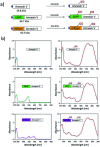
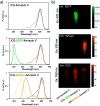

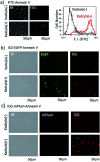
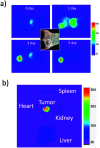
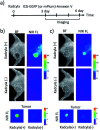
Similar articles
-
Shortwave-infrared (SWIR) emitting annexin V for high-contrast fluorescence molecular imaging of tumor apoptosis in living mice.RSC Adv. 2022 Jul 6;12(30):19632-19639. doi: 10.1039/d2ra03315a. eCollection 2022 Jun 29. RSC Adv. 2022. PMID: 35865555 Free PMC article.
-
In Vitro and In Vivo Fluorescence Imaging of Antibody-Drug Conjugate-Induced Tumor Apoptosis Using Annexin V-EGFP Conjugated Quantum Dots.ACS Omega. 2022 Jan 3;7(2):2105-2113. doi: 10.1021/acsomega.1c05636. eCollection 2022 Jan 18. ACS Omega. 2022. PMID: 35071899 Free PMC article.
-
Biocompatible and Water-Soluble Shortwave-Infrared (SWIR)-Emitting Cyanine-Based Fluorescent Probes for In Vivo Multiplexed Molecular Imaging.ACS Appl Mater Interfaces. 2024 Apr 10;16(14):17253-17266. doi: 10.1021/acsami.4c01000. Epub 2024 Apr 1. ACS Appl Mater Interfaces. 2024. PMID: 38557012
-
Cy5.5-Annexin V.2005 Sep 28 [updated 2005 Oct 31]. In: Molecular Imaging and Contrast Agent Database (MICAD) [Internet]. Bethesda (MD): National Center for Biotechnology Information (US); 2004–2013. 2005 Sep 28 [updated 2005 Oct 31]. In: Molecular Imaging and Contrast Agent Database (MICAD) [Internet]. Bethesda (MD): National Center for Biotechnology Information (US); 2004–2013. PMID: 20641799 Free Books & Documents. Review.
-
Indocyanine green delivery systems for tumour detection and treatments.Biotechnol Adv. 2016 Sep-Oct;34(5):768-789. doi: 10.1016/j.biotechadv.2016.04.001. Epub 2016 Apr 14. Biotechnol Adv. 2016. PMID: 27090752 Review.
Cited by
-
l-Asparaginase from Solanum lycopersicum as a Nutraceutical for Acute Lymphoblastic Leukemia.ACS Omega. 2024 Jan 5;9(3):3616-3624. doi: 10.1021/acsomega.3c07633. eCollection 2024 Jan 23. ACS Omega. 2024. PMID: 38284052 Free PMC article.
-
Shortwave-infrared (SWIR) emitting annexin V for high-contrast fluorescence molecular imaging of tumor apoptosis in living mice.RSC Adv. 2022 Jul 6;12(30):19632-19639. doi: 10.1039/d2ra03315a. eCollection 2022 Jun 29. RSC Adv. 2022. PMID: 35865555 Free PMC article.
-
In Vitro and In Vivo Fluorescence Imaging of Antibody-Drug Conjugate-Induced Tumor Apoptosis Using Annexin V-EGFP Conjugated Quantum Dots.ACS Omega. 2022 Jan 3;7(2):2105-2113. doi: 10.1021/acsomega.1c05636. eCollection 2022 Jan 18. ACS Omega. 2022. PMID: 35071899 Free PMC article.
References
-
- Kim S. Cha K. Kim I. S. Curr. Mol. Imaging. 2012;1:55–62. doi: 10.2174/2211555211201010055. - DOI
LinkOut - more resources
Full Text Sources

